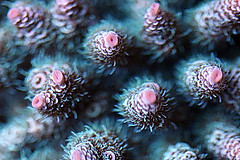
Corals are marine animals and are typically in colonies of many identical individuals.
Many writers and reef enthusiasts call the reefs as rainforests of the ocean. They settle and grow for a period of 1000 years or longer.
Individual species divide and they grow literally on or on the top of their ancestors. Then over a period of time, they would grow into massive reefs.

The Great Barrier Reef of Australia stretches over 620 miles (2000 km) and is believed to be the “largest structure created by living organisms on the planet.”
Coral reefs are the most biology diverse group of earths ecosystem. Not just corals itself, but thousands of species of fish, invertebrates and seaweeds are connected and form the reef.
They are very popular among saltwater aquarium hobbyists. Saltwater aquariums that has them became very popular after the mini reef introduction in the 1980s. And they continue to grow! The increase is mainly due to purchases by hobbyists for their minireefs.
Conservation Issues
You can obviously see now that there are all types of corals that are being propagated for the aquarium trade.
The best choice for propagations is the ones that reproduce themselves under captive conditions.
Unfortunately, less than 1 percent of the colonies that we buy from either our local store or the internet come from captive propagation.
Yup, most of them came directly from the reefs of the ocean all over the world.
The mortality rate now reaches up to 100 percent on over a quarter of the total world trade. The ones that cannot adapt properly to the new environment are quite a challenge.
Its very clear that taking them out of their natural habitat and keeping them at home is a questionable practice. Collection is already prohibited in many countries, including the US.
The best alternative is captive propagation. There are many facilities now that we call coral farms that is doing this method. It ranges in sizes from what ever can be accommodated in a basement to multi million-dollar facilities.
Hopefully someday, the supply in our aquarium will come exclusively only from these farms.
Beginners are more likely to make deadly mistakes. So it is wiser to keep the inexpensive, captive grown specimens. Also, keeping captive-propagated ones likely to be more successful. Instructions and maintenance are usually available from the produces.
Reef Aquariums

Consider these factors when keeping these amazing species:
- Lighting or illumination. It varies form bright in shallow water to dim in deep or shaded areas.
- Water movement. It ranges from calm in sheltered lagoons to heave surf at the top of the outer reef.
- Chemical stability. This is vital for essential physiological process.
- Aggression. Putting them close together in your aquarium plays an important part.
- Your ability to observe the signs of trouble and take the necessary action.
Aquariums with corals gives us a peek of a real reef out in the wild. The aquarium becomes a “mini reef.”
A mini reef aquarium for me is a work of art. Its beauty is acquired from growth and interaction of one another.
Return from Corals to Main Page
